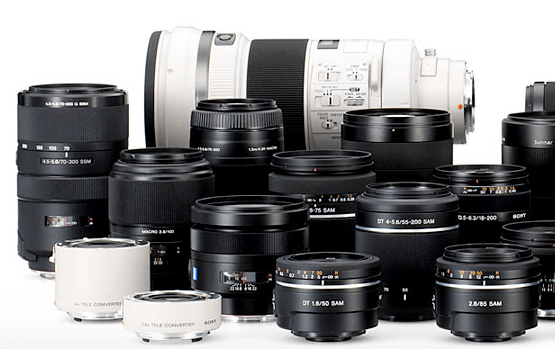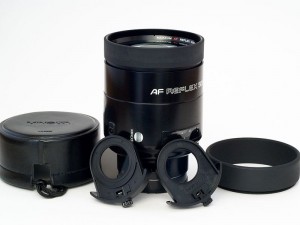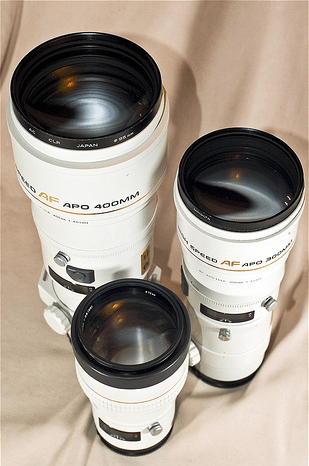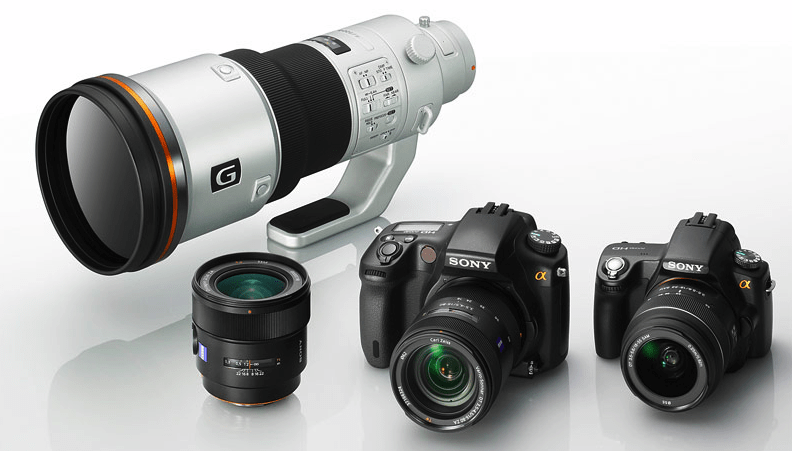When Sony first entered the SLR market in 2006, not many people were sure it would be a successful move for a company with a no significant reputation outside of the compact point-n-shoot world of cameras. However, they drew a bold ace by buying the assets of Konica-Minolta (essentially all SLR photography assets for Minolta). This made Sony able to compete in the world of SLR photography using the already existing range of SLR lenses from Minolta.

Today, Sony extended this to include the excellent lenses from Carl Zeiss, but it is less significant than the already large set of tele-lenses from Minolta. Actually, this company had designed an impressive set of long focal prime lenses and a nice set of pro zoom lenses.
Wildlife photographers will actually find a wealth of very good quality lenses even if some of them are either second-hand lenses or re-branded Minolta lenses incorporated into the Sony line-up. But the best news for them is that since Sony incorporates Image Stabilization in the body rather than the lenses, all old Minolta glass immediately got IS when used on a Sony SLR camera like the Alpha 700 or the Alpha 900. A real treat for people willing to use second-hand lenses from eBay…
Amateur
If your priority is to keep the total budget at a rock bottom level, there are two interesting lenses to watch for. The first and most impressive one if the 70-400mm f/4-5,6G SAL-70400G. A recent design from Sony, this is widely considered as the best zoom lens of this category (Canon 100-400mm offering is just not as good and Nikon’s 80-400mm is clearly of lower quality). The price is not small but it gives quite a focal length range.

Interestingly, there is another lens that Sony wildlife SLR photographer should also consider: The 500mm f/8 Reflex SAL-500F80 is a mirror (or reflex) lens, so it brings all the good and bad of such a technology.
Good: Impossibly light 500mm lens (stabilized by the SLR body, of course) with a reasonable quality.
Bad: The fixed aperture is forcing to choose shutter speed against ISO sensitivity.
Bonus: While most mirror/reflex lenses do not allow AF, this is the only reflex lens on the market that can auto-focus on all the Alpha-series SLR bodies.
Speaking of cameras, Sony has a large choice (too large?) of SLR cameras. I will risk a recommendation of the Alpha 55. Despite being really flawed for video capture (an overheating sensor is strongly limiting the length of video clips), it offers an excellent 16MP digital APS-C photo sensor with good AF and amazingly fast continuous shooting rates (10 fps) if you can tolerate the ugly electronic viewfinder.
For landscape photography, use the Sony 18-70mm f/3.5-5.6 DT SAL-1870 that will probably come in kit with your camera bosy. This is a bargain.
Enthusiast
The expert photographer will take advantage of second-hand lenses and this is the real good surprise of the Sony solution for wildlife and nature photographers. Prices can drop significantly here while I recommend taking advantage of the exceptional prime lenses available.
Your first choice must be second-hand since these are only from Minolta: Select the 300mm f/4 APO G and the 400mm f/4,5 APO G (two of the “white primes” of the pro G line of Minolta). Relatively light weight and impressively good quality makes these obvious choices. The only real issue is that the 400mm is very rare. You may have to spend some real time looking for it even on eBay. Despite that, prices stay at a reasonable level.

Quite significantly, all the APO G tele-lenses have been designed by Minolta with the focal multipliers in mind, to the point that the focal doubler doesn’t degrade images as much as doublers for Canon or Nikon brands). I recommend strongly the 1,4x multiplier from Sony (or the older Minolta branded if it is a mint-quality second-hand).
Currently, Sony problem is that there is no SLR body that can seriously be recommended here: The Alpha 55 electronic viewfinder will not satisfy any of the enthusiast photographers. The only reasonable choice is between the Alpha 850 (or Alpha 900) and the upcoming/promised replacement for the Alpha 700. A full frame SLR like the A850/A900 is tempting because of its exceptionally good price (under 2000$) but you will loose the focal extension provided by APS-C sensors while the A850/A900 are not very reactive (relatively slow AF and limited continuous shooting). The Alpha 700 is still a good camera at a very good price, but it is now ready for a replacement in 2011. If Sony does not install in it one of their (successful but ugly) electronic viewfinders, the Alpha 750 (tentative name) will be a better choice.
Complementing the initial prime tele-lenses, you would add a Sony 24-70mm f/2.8 ZA Carl Zeiss Vario Sonnar T* SAL-2470Z (same as before) and possibly a Sony 16-35mm f/2.8 Carl Zeiss Vario Sonnar T* SAL-1635ZA. Both are expensive and heavy gear, but you can’t get any better.
In between, a Konica Minolta 200mm f/2.8 APO G AF would be a nice complement for a relatively short tele lens.
Pro
Unfortunately, Sony does not provide a perfect solution set at the pro level. The camera body choice will be limited by the same constraints as above for the expert/enthusiast (either A850/A900 or future A750). 2011 may also bring a new pro-level SLR camera body but nothing is really certain here.
Nevertheless, the long prime lens choice is relatively easy: Go for the Sony 300mm f/2.8 G SAL-300F28G which has all the bells and whistles of the top-quality glass deriving from the original Minolta design updated to the latest standards (including SSM smooth focus).
While you could keep the good old Minolta 400mm f/4,5 APO G previously mentioned, I am sure you are thinking about a 500mm. Unfortunately, while Sony has been showing models, we are still waiting for this lens (probably in February 2011). Quality should be there, since price and weight will be no issue.
As for the expert, before, these tele-lenses will be complemented with a Sony 24-70mm f/2.8 ZA Carl Zeiss Vario Sonnar T* SAL-2470Z and a Sony 16-35mm f/2.8 Carl Zeiss Vario Sonnar T* SAL-1635ZA. I would also add the pro-level (G-series) Sony 70-200mm f/2.8 G SAL-70200G zoom lens, for its quality and its SSM focus.
Conclusion
Really, Sony takes full advantage of the existing Minolta line-up of lenses. For example, the Minolta 400mm f/4,5 APO G is simply impressive for a cost usually under 2000$ and a weight compatible with most back-packs.
However, the mix of new technologies and relative lack of understanding of pro photographer needs for the SLR camera bodies, puts Sony is a dire position. It is no surprise that, currently, Sony cameras are not often seen in the bags of photo-safari travelers.
However, the arrival of new 2011 SLR bodies and of a world-class 500mm f/4 prime lens could gradually change this.
In between, Since we don’t often see wildlife photographers equipped with Sony gear, here is a David Bittner video clip where you may find some of the lenses lenses and camera bodies listed above. Will you be able to recognize the 300mm f/2.8 lens or the 70-200mm zoom?
YouTube link

